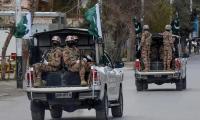There have been a plethora of reports in the media about Pakistan's nuclear programme while mostly ignoring India's.
Director of National Intelligence Dan Coats told US lawmakers during a Congressional hearing on worldwide threats organised by the Senate Select Committee on Intelligence that Pakistan was developing new types of nuclear weapons, including short-range tactical ones, that bring more risks to the region. He claimed that "Pakistan continues to produce nuclear weapons and develop new types of nuclear weapons, including short-range tactical weapons, sea-based cruise missiles, air-launched cruise missiles, and longer-range ballistic missiles. These new types of nuclear weapons will introduce new risks for escalation of dynamics and security in the region."
Another report by Kristensen and Robert Norris claimed that Pakistan has a rapidly expanding nuclear arsenal of 130-140 warheads and an increasing portfolio of delivery systems. It said Islamabad is quantitatively and qualitatively strengthening its arsenal and deploying weapons at more sites.
Meanwhile, Tom Hundley stated in a report: "Pakistan says its decision to add nuclear weapons to its navy is a direct response to India’s August 2016 deployment of its first nuclear submarine, the Arihant. A second, even more advanced Indian nuclear submarine, the Arighat, began sea trials last November, and four more boats are scheduled to join the fleet by 2025. That will give India a complete nuclear triad, which means the country will have the ability to deliver a nuclear strike by land-based missiles, by warplanes, and by submarines."
He admitted that "India has spent billions of dollars to join that exclusive club — and came close to disaster. The $2.9 billion Arihant nearly sank a few months after its commissioning when a hatch was left open and seawater flooded the propulsion compartment. The embarrassing mishap, blamed on human error, was hushed up by the ministry of defense. Even India’s senior political leadership was kept in the dark. The boat has been undergoing extensive repairs since February 2017, according to a January 8 report in the newspaper the Hindu, which was the first to report the entire saga."
Meanwhile, "India’s other nuclear submarine, the INS Chaka — an Akula-class submarine on loan from Russia primarily for training purposes — is also in dry dock after an unspecified accident damaged its sensitive sonar equipment. In February, Russia sent India a $20 million bill for repairs. The problem is that putting nukes at sea significantly weakens the chain of command and control over the weapons, which means the risk of an accidental exchange of fire — or full-on nuclear war — between India and Pakistan will increase exponentially."
Hundley was however categorical in stating that "most experts agree that Pakistan has done a good job safeguarding its nuclear weapons. Protecting the nukes — from India, from homegrown terrorists, and from the US military, which has spent millions of dollars helping Pakistan secure its nuclear arsenal but still remains a suspect ally — is Pakistan’s highest priority."
He quoted a senior official as saying that Pakistan “is very much alive” to the dangers of managing nuclear weapons at sea. The official added: “We are confident but not complacent... Managing nuclear safety and security is not a white man’s burden only Pakistan is managing its responsibilities quite well. There is a deliberate tendency to forget that Pakistan’s record is as good, if not better, than that of the US.”
On the other hand, the commander of the Indian Air Force, Air Chief Marshal Birender Singh Dhanoa, recently claimed that his pilots had the capability to locate and eliminate nuclear and other strategic targets in Pakistan. He was speaking at the annual Air Force Day press conference on IAF response to Pakistan’s store of tactical nuclear weapons. “As far as IAF is concerned, it has the ability to locate, fix and strike and that is not only for tactical nuclear weapons but also for other targets across the border,” he had said during the annual Air Force Day press conference.
While the world should be rest assured that Pakistan takes the security of its nuclear weapons most seriously, it should not forget what India is doing in nuclear field and its not-so-enviable track record. The US Foreign Policy magazine had reported that India had built two top-secret facilities in Karnataka to enrich uranium in pursuit of its hydrogen bomb plans. Ostensibly, at Challakere, Karnataka, South Asia’s largest military-run complex of nuclear centrifuges, atomic-research laboratories and weapons and aircraft-testing facilities, the stated aims of the project are to “expand the government's nuclear research, to produce fuel for India's nuclear reactors, and to help power the country's fleet of new submarines.”
International experts, especially Adrian Levy, believe, “this new facility will give India a nuclear capability -- the ability to make many large-yield nuclear arms -- that most experts say it presently lacks.”
This article reflects on key sporting moments, featuring Pakistan’s triumphs and shortcomings throughout 2024
JUIF’s legal adviser, Senator Kamran Murtaza, is also engaged in consultation process
Sit-in Action Committee decides to call a grand jirga for recovery of Muasawar Kakar
Abbasi says that neither government nor opposition sincerely intended dialogue







